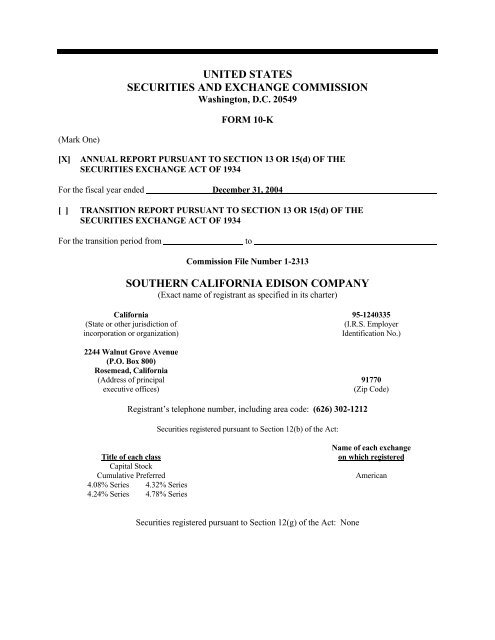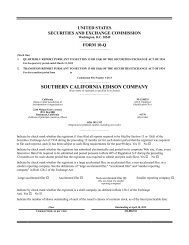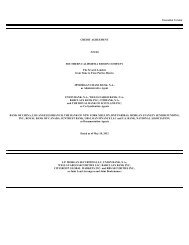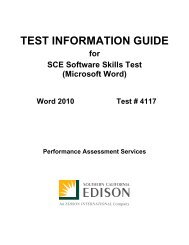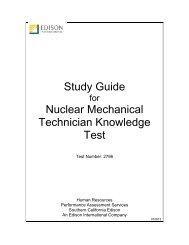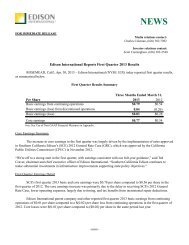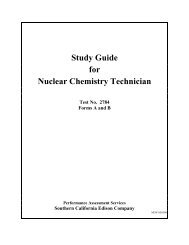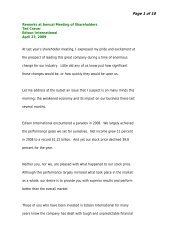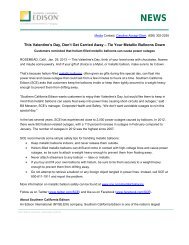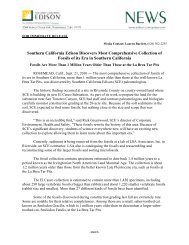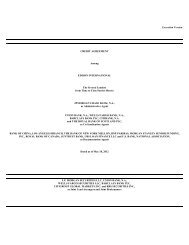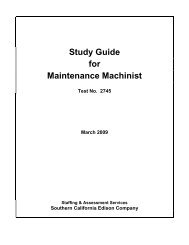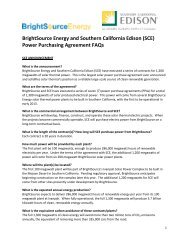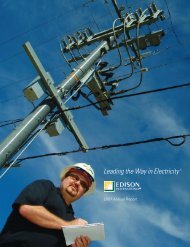10-K - Edison International
10-K - Edison International
10-K - Edison International
Create successful ePaper yourself
Turn your PDF publications into a flip-book with our unique Google optimized e-Paper software.
UNITED STATESSECURITIES AND EXCHANGE COMMISSIONWashington, D.C. 20549FORM <strong>10</strong>-K(Mark One)[X]ANNUAL REPORT PURSUANT TO SECTION 13 OR 15(d) OF THESECURITIES EXCHANGE ACT OF 1934For the fiscal year ended December 31, 2004[ ] TRANSITION REPORT PURSUANT TO SECTION 13 OR 15(d) OF THESECURITIES EXCHANGE ACT OF 1934For the transition period fromtoCommission File Number 1-2313SOUTHERN CALIFORNIA EDISON COMPANY(Exact name of registrant as specified in its charter)California 95-1240335(State or other jurisdiction of(I.R.S. Employerincorporation or organization)Identification No.)2244 Walnut Grove Avenue(P.O. Box 800)Rosemead, California(Address of principal 91770executive offices)(Zip Code)Registrant’s telephone number, including area code: (626) 302-1212Securities registered pursuant to Section 12(b) of the Act:Title of each classCapital StockCumulative Preferred4.08% Series 4.32% Series4.24% Series 4.78% SeriesName of each exchangeon which registeredAmericanSecurities registered pursuant to Section 12(g) of the Act: None
TABLE OF CONTENTSItemPageForward-Looking Statements.................................................................................................................. 1Part I1. Business............................................................................................................................................ 1Regulation.................................................................................................................................. 1Competition ............................................................................................................................... 3Properties ................................................................................................................................... 3Nuclear Power Matters .............................................................................................................. 5Purchased Power and Fuel Supply............................................................................................. 5Discontinued Operations............................................................................................................ 7Seasonality ................................................................................................................................. 7Environmental Matters............................................................................................................... 7Financial Information About Geographic Areas........................................................................ 142. Properties.......................................................................................................................................... 143. Legal Proceedings ............................................................................................................................ 14Navajo Nation Litigation ........................................................................................................... 144. Submission of Matters to a Vote of Security Holders...................................................................... 14Executive Officers of the Registrant.......................................................................................... 15Part II5. Market for Registrant’s Common Equity, Related Stockholder Matters and IssuerPurchases of Equity Securities ......................................................................................................... 176. Selected Financial Data .................................................................................................................... 177. Management’s Discussion and Analysis of Financial Condition and Results of Operations........... 177A. Quantitative and Qualitative Disclosures About Market Risk ......................................................... 178. Financial Statements and Supplementary Data ................................................................................ 179. Changes in and Disagreements with Accountants on Accounting and Financial Disclosure .......... 179A. Controls and Procedures................................................................................................................... 179B. Other Information............................................................................................................................. 18Part III<strong>10</strong>. Directors and Executive Officers of the Registrant.......................................................................... 1811. Executive Compensation.................................................................................................................. 1812. Security Ownership of Certain Beneficial Owners and Management.............................................. 1813. Certain Relationships and Related Transactions .............................................................................. 1914. Principal Accounting Fees and Services .......................................................................................... 1915. Exhibits and Financial Statement Schedules.................................................................................... 19Financial Statements .................................................................................................................. 19Report of Independent Registered Public Accounting Firm andSchedules Supplementing Financial Statements ................................................................. 19Exhibits ...................................................................................................................................... 19Signatures ......................................................................................................................................... 24
FORWARD-LOOKING STATEMENTSThis Annual Report on Form <strong>10</strong>-K contains forward-looking statements that reflect Southern California<strong>Edison</strong> Company’s (SCE) current expectations and projections about future events based on SCE’sknowledge of present facts and circumstances and assumptions about future events. Other informationdistributed by SCE that is incorporated in this report, or that refers to or incorporates this report, may alsocontain forward-looking statements. In this report and elsewhere, the words “expects,” “believes,”“anticipates,” “estimates,” “intends,” “plans,” “probable,” and variations of such words and similarexpressions are intended to identify forward-looking statements. Such statements necessarily involverisks and uncertainties that could cause actual results to differ materially from those anticipated. Some ofthe risks, uncertainties and other important factors that could cause results to differ, or that otherwisecould impact SCE are referred to in the first paragraph of the Introduction in the Management’sDiscussion and Analysis of Financial Condition and Results of Operations (MD&A) that appears inSCE’s 2004 Annual Report to Shareholders (Annual Report), a copy of which is filed as Exhibit 13 to thisForm <strong>10</strong>-K, and is incorporated by reference into Part II, Item 7 of this report.Additional information about risks and uncertainties is contained throughout this report, in the MD&A, andin the Notes to Consolidated Financial Statements (Notes to Financial Statements) that appear in SCE’sAnnual Report and are incorporated by reference into Part II, Item 8 of this report. Readers are urged toread this entire report, including the information incorporated by reference, and carefully consider the risks,uncertainties and other factors that affect SCE’s business. The information contained in this report issubject to change without notice, and SCE is not obligated to publicly update or revise forward-lookingstatements. Readers should review future reports filed by SCE with the Securities and ExchangeCommission (SEC).Item 1. BusinessPART ISCE was incorporated in 1909 under the laws of the State of California. SCE is a public utility primarilyengaged in the business of supplying electric energy to a 50,000-square-mile area of central, coastal andsouthern California, excluding the City of Los Angeles and certain other cities. This SCE service territoryincludes approximately 430 cities and communities and a population of more than 13 million people. In2004, SCE’s total operating revenue was derived as follows: 39% commercial customers, 32% residentialcustomers, 8% other electric revenue, 7% industrial customers, 7% resale sales, 6% public authorities,and 1% agricultural and other customers. At December 31, 2004, SCE had consolidated assets of$23.3 billion and total shareholder’s equity of $4.6 billion. SCE had 13,463 full-time employees atyear-end 2004.Information about SCE is available on the internet website maintained by <strong>Edison</strong> <strong>International</strong> athttp://www.edisoninvestor.com. SCE makes available, free of charge on that internet website, its AnnualReport on Form <strong>10</strong>-K, Quarterly Reports on Form <strong>10</strong>-Q, Current Reports on Form 8-K, and amendmentsto those reports filed or furnished pursuant to Section 13(a) or 15(d) of the Securities Exchange Act of1934, as soon as reasonably practicable after SCE electronically files such material with, or furnishes itto, the SEC. Such reports are also available on the SEC’s internet website at http://www.sec.gov.RegulationSCE’s retail operations are subject to regulation by the California Public Utilities Commission (CPUC).The CPUC has the authority to regulate, among other things, retail rates, issuance of securities, andaccounting practices. SCE’s wholesale operations are subject to regulation by the Federal Energy1
Regulatory Commission (FERC). The FERC has the authority to regulate wholesale rates as well as othermatters, including retail transmission service pricing, accounting practices, and licensing of hydroelectricprojects.Additional information about the regulation of SCE by the CPUC and the FERC, and about SCE’scompetitive environment, appears in the MD&A under the headings “Management Overview” and“Regulatory Matters,” and is incorporated herein by this reference. Also see “Competition” below.SCE is subject to the jurisdiction of the United States Nuclear Regulatory Commission with respect to itsnuclear power plants. United States Nuclear Regulatory Commission regulations govern the granting oflicenses for the construction and operation of nuclear power plants and subject those power plants tocontinuing review and regulation.The construction, planning, and siting of SCE’s power plants within California are subject to thejurisdiction of the California Energy Commission and the CPUC. SCE is subject to the rules andregulations of the California Air Resources Board, State of Nevada, and local air pollution controldistricts with respect to the emission of pollutants into the atmosphere; the regulatory requirements of theCalifornia State Water Resources Control Board and regional boards with respect to the discharge ofpollutants into waters of the state; and the requirements of the California Department of Toxic SubstancesControl with respect to handling and disposal of hazardous materials and wastes. SCE is also subject toregulation by the United States Environmental Protection Agency (US EPA), which administers federalstatutes relating to environmental matters. Other federal, state, and local laws and regulations relating toenvironmental protection, land use, and water rights also affect SCE.The California Coastal Commission issued a coastal permit for the construction of the San OnofreNuclear Generating Station (San Onofre) Units 2 and 3 in 1974. This permit, as amended, requiresmitigation for impacts to fish and the San Onofre kelp bed. California Coastal Commission jurisdictionwill continue for several years due to ongoing implementation and oversight of these permit mitigationconditions, consisting of restoration of wetlands and construction of an artificial reef for kelp. SCE has acoastal permit from the California Coastal Commission to construct a temporary dry cask spent fuelstorage installation for San Onofre Units 2 and 3. The California Coastal Commission also hascontinuing jurisdiction over coastal permits issued for the decommissioning of San Onofre Unit 1,including for the construction of a temporary dry cask spent fuel storage installation for spent fuel fromthat unit.The United States Department of Energy has regulatory authority over certain aspects of SCE’soperations and business relating to energy conservation, power plant fuel use and disposal, electric salesfor export, public utility regulatory policy, and natural gas pricing.SCE is subject to CPUC affiliate transaction rules and compliance plans governing the relationshipbetween SCE and its affiliates. <strong>Edison</strong> <strong>International</strong> is not a public utility under the laws of the State ofCalifornia and is not subject to regulation as such by the CPUC. The CPUC decision authorizing SCE toreorganize into a holding company structure, however, contains certain conditions, which, among otherthings: (1) ensure the CPUC access to books and records of <strong>Edison</strong> <strong>International</strong> and its affiliates whichrelate to transactions with SCE; (2) require <strong>Edison</strong> <strong>International</strong> and its subsidiaries to employ accountingand other procedures and controls to ensure full review by the CPUC and to protect against subsidizationof nonutility activities by SCE’s customers; (3) require that all transfers of market, technological, orsimilar data from SCE to <strong>Edison</strong> <strong>International</strong> or its affiliates be made at market value; (4) preclude SCEfrom guaranteeing any obligations of <strong>Edison</strong> <strong>International</strong> without prior written consent from the CPUC;(5) provide for royalty payments to be paid by <strong>Edison</strong> <strong>International</strong> or its subsidiaries in connection withthe transfer of product rights, patents, copyrights, or similar legal rights from SCE; and (6) prevent <strong>Edison</strong>2
<strong>International</strong> and its subsidiaries from providing certain facilities and equipment to SCE except throughcompetitive bidding. In addition, the decision provides that SCE shall maintain a balanced capitalstructure in accordance with prior CPUC decisions, that SCE’s dividend policy shall continue to beestablished by SCE’s Board of Directors as though SCE were a stand-alone utility company, and that thecapital requirements of SCE, as determined to be necessary to meet SCE’s service obligations, shall begiven first priority by the boards of directors of <strong>Edison</strong> <strong>International</strong> and SCE.In addition, the CPUC has issued affiliate transaction rules governing the relationships between SCE andits affiliates, including <strong>Edison</strong> <strong>International</strong> and <strong>Edison</strong> <strong>International</strong>’s other subsidiaries engaged innonutility businesses. SCE has filed compliance plans which set forth SCE’s implementation of theCPUC’s affiliate transaction rules. The rules and compliance plans are intended to maintain separatenessbetween utility and nonutility activities and ensure that utility assets are not used to subsidize theactivities of nonutility affiliates.CompetitionBecause SCE is an electric utility company operating within a defined service territory pursuant toauthority from the CPUC, SCE faces competition only to the extent that federal and California lawspermit other entities to provide electricity and related services to customers within SCE’s serviceterritory. California law currently provides only limited opportunities for customers to choose topurchase power directly from an energy service provider other than SCE. SCE also faces somecompetition from cities that create municipal utilities or community choice aggregators. In addition,customers may install their own on-site power generation facilities. Competition with SCE is conductedmainly on the basis of price as customers seek the lowest cost power available. The effect of competitionon SCE generally is to reduce the size of SCE’s customer base, thereby creating upward pressure onSCE’s rate structure to cover fixed costs, which in turn may cause more customers to leave SCE in orderto obtain lower rates. Additional information about competition of SCE appears in the MD&A under theheading “Regulatory Matters—Generation and Power Procurement—Direct Access and CommunityChoice Aggregation,” and is incorporated herein by this reference.PropertiesSCE supplies electricity to its customers through extensive transmission and distribution networks. Itstransmission facilities, which deliver power from generating sources to the distribution network, consistof approximately 7,200 circuit miles of 33 kilovolt (kV), 55 kV, 66 kV, 115 kV, and 161 kV lines and3,522 circuit miles of 220 kV lines (all located in California), 1,238 circuit miles of 500 kV lines(1,040 miles in California, 86 miles in Nevada, and 112 miles in Arizona), and 857 substations (all inCalifornia). SCE’s distribution system, which takes power from substations to the customer, includesapproximately 60,398 circuit miles of overhead lines, 36,841 circuit miles of underground lines,1.5 million poles, 566 distribution substations, 691,000 transformers, and 765,000 area and street lights,all of which are located in California.SCE owns and operates the following generating facilities: (1) an undivided 75.05% interest(1,614 megawatts (MW)) in San Onofre Units 2 and 3, which are large pressurized water nuclear unitslocated on the California coastline between Los Angeles and San Diego; (2) 36 hydroelectric plants(1,175 MW) located in California’s Sierra Nevada, San Bernardino and San Gabriel mountain ranges, threeof which (2.7 MW) are no longer operational; (3) a diesel-fueled generating plant (9 MW) and onehydroelectric plant (0.11 MW) located on Santa Catalina island off the southern California coast; and (4) anundivided 56% interest (885 MW net) in the Mohave Generating Station, which consists of twocoal-fueled generating units located in Clark County, Nevada near the California border.3
SCE also owns an undivided 15.8% interest (601 MW) in Palo Verde Nuclear Generating Station, whichis located near Phoenix, Arizona, and an undivided 48% interest (7<strong>10</strong> MW) in Units 4 and 5 at FourCorners Generating Station, which is a coal-fueled generating plant located near the City of Farmington,New Mexico. The Palo Verde and Four Corners plants are operated by Arizona Public Service Company.On March 12, 2004, SCE acquired Mountainview Power Company LLC, which owns a power plant underconstruction in Redlands, California. SCE recommenced full construction of the approximately$600 million project, which is expected to be completed in early 2006. When completed, the Mountainviewproject will have a generating capacity of 1,054 MW.At year-end 2004, the SCE-owned generating capacity (summer effective rating) was dividedapproximately as follows: 45% nuclear, 32% coal, 23% hydroelectric, and less than 1% diesel. Thecapacity factors in 2004 for SCE’s nuclear and coal-fired generating units were: 80% for San Onofre; 73%for Mohave; 83% for Four Corners; and 84% for Palo Verde. For SCE’s hydroelectric plants, generatingcapacity is dependent on the amount of available water. Therefore, while SCE’s hydroelectric plantsoperated at a 35% capacity factor in 2004 due to a below normal water year, these plants were operationallyavailable for 92.1% of the year.The San Onofre units, Four Corners station, certain of SCE’s substations, and portions of its transmission,distribution and communication systems are located on lands of the United States or others under (withminor exceptions) licenses, permits, easements or leases, or on public streets or highways pursuant tofranchises. Certain of such documents obligate SCE, under specified circumstances and at its expense, torelocate transmission, distribution, and communication facilities located on lands owned or controlled byfederal, state, or local governments.Thirty-one of SCE’s 36 hydroelectric plants (some with related reservoirs) are located in whole or in parton United States lands pursuant to 30- to 50-year FERC licenses that expire at various times between2005 and 2039 (the remaining five plants are located entirely on private property and are not subject toFERC jurisdiction). Such licenses impose numerous restrictions and obligations on SCE, including theright of the United States to acquire projects upon payment of specified compensation. When existinglicenses expire, the FERC has the authority to issue new licenses to third parties that have filed competinglicense applications, but only if their license application is superior to SCE’s and then only upon paymentof specified compensation to SCE. New licenses issued to SCE are expected to contain more restrictionsand obligations than the expired licenses because laws enacted since the existing licenses were issuedrequire the FERC to give environmental purposes greater consideration in the licensing process. SCE’sapplications for the relicensing of certain hydroelectric projects with an aggregate dependable operatingcapacity of approximately 22 MW are pending. Annual licenses have been issued to SCE hydroelectricprojects that are undergoing relicensing and whose long-term licenses have expired. Federal Power ActSection 15 requires that the annual licenses be renewed until the long-term licenses are issued or denied.Substantially all of SCE’s properties are subject to the lien of a trust indenture securing First andRefunding Mortgage Bonds, of which approximately $4.92 billion in principal amount was outstandingon March <strong>10</strong>, 2005 (including the First Mortgage Bonds issued to secure a $1.25 billion revolving creditfacility). Such lien and SCE’s title to its properties are subject to the terms of franchises, licenses,easements, leases, permits, contracts, and other instruments under which properties are held or operated,certain statutes and governmental regulations, liens for taxes and assessments, and liens of the trusteesunder the trust indenture. In addition, such lien and SCE’s title to its properties are subject to certainother liens, prior rights and other encumbrances, none of which, with minor or insubstantial exceptions,affect SCE’s right to use such properties in its business, unless the matters with respect to SCE’s interestin the Four Corners plant and the related easement and lease referred to below may be so considered.4
SCE’s rights in the Four Corners station, which is located on land of the Navajo Nation of Indians underan easement from the United States and a lease from the Navajo Nation, may be subject to possibledefects. These defects include possible conflicting grants or encumbrances not ascertainable because ofthe absence of, or inadequacies in, the applicable recording law and the record systems of the Bureau ofIndian Affairs and the Navajo Nation, the possible inability of SCE to resort to legal process to enforce itsrights against the Navajo Nation without Congressional consent, the possible impairment or terminationunder certain circumstances of the easement and lease by the Navajo Nation, Congress, or the Secretaryof the Interior, and the possible invalidity of the trust indenture lien against SCE’s interest in theeasement, lease, and improvements on the Four Corners station.Nuclear Power MattersSan Onofre Nuclear Generating StationInformation about operating issues related to San Onofre appears in the MD&A under the heading“Regulatory Matters—Generation and Power Procurement—San Onofre Nuclear Generating Station,”and is incorporated herein by this reference.Palo Verde Plant Steam GeneratorsInformation about Palo Verde steam generator replacements appears in the MD&A under the heading“Regulatory Matters—Generation and Power Procurement—Palo Verde Steam Generators,” and isincorporated herein by this reference.Nuclear DecommissioningInformation about nuclear decommissioning can be found in Note 9 of Notes to Financial Statements andis incorporated herein by this reference.Nuclear InsuranceInformation about nuclear insurance can be found in Note <strong>10</strong> of Notes to Financial Statements and isincorporated herein by this reference.Purchased Power and Fuel SupplySCE obtains the power needed to serve its customers from its generating facilities and from purchases fromqualifying facilities, independent power producers, the California Independent System Operator, and otherutilities. In addition, power is provided to SCE’s customers through purchases by the California Departmentof Water Resources (CDWR) under contracts with third parties. Sources of power to serve SCE’scustomers during 2004 were as follows: 31.5% purchased power; 30.3% CDWR; and 38.2% SCE-ownedgeneration consisting of 13.7% nuclear, 20.0% coal, and 4.5% hydro. Additional information about SCE’spower procurement activities appears in the MD&A under the heading “Regulatory Matters—Generationand Power Procurement,” and is incorporated herein by this reference.Natural Gas SupplySCE’s natural gas requirements in 2004 were for start-up use at the Mohave coal-fired generation facilityand to meet contractual obligations for power tolling agreements. All of the physical gas purchased bySCE in 2004 was purchased under North American Energy Standards Board agreements (master gas5
agreements) that define the terms and conditions of transactions with a particular supplier prior to anyfinancial commitment.SCE contracted for firm access rights onto the Southern California Gas Company system at WheelerRidge for 198,863 million British thermal units (MMBtu) per day in a 13-year contract entered into inAugust 1993, effective November 1, 1993. SCE also has firm transportation rights of 18,000 MMBtu perday on Southwest Gas Corp’s pipeline to serve Mohave generation facility.In 2004, SCE secured a one-year natural gas storage capacity contract with Southern California GasCompany for the 2004/2005 storage season. In 2005, SCE secured a one-year natural gas storagecapacity contract with Southern California Gas Company for the 2005/2006 storage season. Storagecapacity was secured to provide operation flexibility and to mitigate potential costs associated with thedispatch of SCE’s tolling agreements.Nuclear Fuel SupplyFor San Onofre Units 2 and 3, contractual arrangements are in place covering <strong>10</strong>0% of the projectednuclear fuel requirements through the years indicated below:Uranium concentrates ...................................................................................... 2008Conversion................................................................................................ 2008Enrichment................................................................................................ 2008Fabrication ................................................................................................ 2015For Palo Verde, contractual arrangements are in place covering <strong>10</strong>0% of the projected nuclear fuelrequirements through the years indicated below:Uranium concentrates ...................................................................................... 2008Conversion................................................................................................ 2008Enrichment................................................................................................ 2008Fabrication ................................................................................................ 2015Spent Nuclear FuelInformation about Spent Nuclear Fuel appears in Note <strong>10</strong> of Notes to Financial Statements and isincorporated herein by this reference.Coal SupplySCE purchases coal pursuant to long term contracts to provide stable and reliable fuel supplies to itstwo coal-fired generating stations, the Mohave and Four Corners plants. SCE entered into a coal contract,dated September 1, 1966, with BHP Navajo Coal Company, the predecessor to the current owner of theNavajo mine, to supply coal to Four Corners Units 4 and 5. The initial term of this coal supply contractfor the Four Corners plant was through 2004 and included extension options for up to 15 additional years.On January 1, 2005 SCE and the other Four Corners participants entered into a Restated and AmendedFour Corners Fuel Agreement under which coal will be supplied until July 6, 2016. The Restated andAmended Agreement contains an option to extend for not less than five additional years or more than15 years. Additional information about the litigation affecting the coal supply contract for the Mohaveplant appears in the MD&A under the heading “Other Developments—Navajo Nation Litigation,” and isincorporated herein by this reference. SCE does not have reasonable assurance of an adequate coal6
supply for operating the Mohave plant after 2005. If reasonable assurance of an adequate coal supply isnot obtained, it will become necessary to shut down the Mohave plant after December 31, 2005.Discontinued OperationsInformation about SCE’s discontinued operations appears in Note 12 of Notes to Financial Statementsand is incorporated herein by this reference.SeasonalityDue to warmer weather during the summer months, electric utility revenue during the third quarter ofeach year is generally significant higher than other quarters.Environmental MattersSCE is subject to environmental regulation by federal, state and local authorities in the jurisdictions inwhich it operates in the United States. This regulation, including the areas of air and water pollution,waste management, hazardous chemical use, noise abatement, land use, aesthetics, and nuclear control,continues to result in the imposition of numerous restrictions on SCE’s operation of existing facilities, onthe timing, cost, location, design, construction, and operation by SCE of new facilities, and on the cost ofmitigating the effect of past operations on the environment.SCE believes that it is in substantial compliance with environmental regulatory requirements and thatmaintaining compliance with current requirements will not materially affect its financial position orresults of operations. However, possible future developments, such as the promulgation of more stringentenvironmental laws and regulations, future proceedings that may be initiated by environmentalauthorities, and settlements agreed to by other companies could affect the costs and the manner in whichSCE conducts its business and could cause it to make substantial additional capital or operationalexpenditures. There is no assurance that SCE would be able to recover these increased costs from itscustomers or that SCE’s financial position and results of operations would not be materially adverselyaffected. SCE is unable to predict the extent to which additional regulations may affect its operations andcapital expenditure requirements.Typically, environmental laws and regulations require a lengthy and complex process for obtaininglicenses, permits and approvals prior to construction, operation or modification of a project. Meeting allthe necessary requirements can delay or sometimes prevent the completion of a proposed project as wellas require extensive modifications to existing projects, which may involve significant capital oroperational expenditures. Furthermore, if SCE fails to comply with applicable environmental laws, itmay be subject to injunctive relief, penalties and fines imposed by regulatory authorities.Air QualitySCE’s facilities, including in particular the Mohave plant located in Laughlin, Nevada, and theFour Corners plant located in the Four Corners area of New Mexico, are subject to various air qualityregulations, including the Federal Clean Air Act and similar state and local statutes.Mohave Consent Decree. In 1998, several environmental groups filed suit against the co-owners of theMohave plant regarding alleged violations of emissions limits. In order to resolve the lawsuit andaccelerate resolution of key environmental issues regarding the plant, the parties entered into a consentdecree, which was approved by the Nevada federal district court in December 1999. The decree alsoaddressed concerns raised by the US EPA programs regarding regional haze and visibility. As to regional7
haze, the US EPA issued final rulemaking on July 1, 1999, that did not impose any additional emissionscontrol requirements on the Mohave plant beyond meeting the provisions of the consent decree. As tovisibility, the US EPA issued its final rule regarding visibility impairment at the Grand Canyon onFebruary 8, 2002. This final rule incorporated the terms of the consent decree into the Visibility FederalImplementation Plan for the State of Nevada, making the terms of the consent decree federallyenforceable.SCE’s share of the costs of complying with the consent decree and taking other actions to continueoperation of the Mohave plant beyond 2005 is estimated to be approximately $605 million overapproximately the next four years. On December 3, 2004, the CPUC approved a decision authorizingcertain expenditures related to securing agreements with the Navajo Nation and the Hopi Tribe regardingan alternate water supply for use in a slurry pipeline for transporting coal fuel from the Black Mesa Mineto the Mohave plant, among other limited expenditures. The CPUC left for a later decision (if agreementcan be reached between the Mohave co-owners and the Tribes on post 2005 water and coal supply needs),the approval of capital funds for retrofit of air pollution controls and related equipment needed forcompliance with the consent decree, and for continued operation of Mohave past 2005. It is not currentlyknown whether such an agreement on water and coal supplies for Mohave will be reached with theTribes.Additional information about these issues appears in the MD&A under the headings “OtherDevelopments—Environmental Matters,” and “Regulatory Matters—Generation and PowerProcurement—Mohave Generating Station and Related Proceedings,” and is incorporated herein by thisreference.Mercury. In December 2000, the US EPA announced its intent to regulate mercury emissions and otherhazardous air pollutants from coal-fired electric power plants under Section 112 of the Clean Air Act, andindicated that it would propose a rule to regulate these emissions. On January 30, 2004, the US EPApublished proposed rules for regulating mercury emissions from coal fired power plants. The US EPAproposed two rule options for public comment: (1) regulate mercury as a hazardous air pollutant underSection 112(d) of the Clean Air Act; or (2) rescind the US EPA’s December 2000 finding regarding aneed to control coal power plant mercury emissions as a hazardous air pollutant, and instead, promulgatea new “cap and trade” emissions regulatory program to reduce mercury emissions in two phases by years20<strong>10</strong> and 2018. On March 16, 2004, the US EPA published a Supplemental Notice of ProposedRulemaking that provides more details on its emissions cap and trade proposal for mercury, and onNovember 30, 2004, the US EPA issued a Notice of Data Availability (NODA) requesting comments onadditional modeling and other data the US EPA was considering in development of its final rule. TheNODA public comment period closed on January 2, 2005. At this time, the US EPA anticipatesfinalizing the regulations on March 15, 2005, with controls required to be in place on existing units byMarch 15, 2008 (if the technology-based standard is chosen) and 20<strong>10</strong> (when Phase I of the cap and tradeapproach would be implemented if this approach is chosen).For SCE, these regulations will primarily impact its operation of the Mohave Generating Station.Additional information regarding the future operation or shutdown of the Mohave Generating Stationappears in the MD&A under the heading “Regulatory Matters—Generation and Power Procurement—Mohave Generating Station and Related Proceedings,” and is incorporated herein by this reference. Atthis point, based on the January 30, 2004, notice proposing technology based standards, SCE believes thatits Mohave Generating Station would likely meet those proposed standards (if the other issues related toMohave are resolved and the station is in operation). Also, based on the preliminary informationprovided in the US EPA’s January 30, 2004, and March 16, 2004, notices regarding a proposed mercurycap and trade program, SCE believes that Mohave would likely have adequate allocations of mercury8
credits for Phase I (20<strong>10</strong>); however, beginning at Phase II (2018), it appears that Mohave would need toeither purchase mercury allocation credits or install mercury controls.Until the mercury regulations are finalized and a final resolution is reached as to whether or not theMohave Generating Station will operate beyond 2005, however, SCE cannot fully evaluate the potentialimpact of these regulations on the operations of all of its facilities. Additional capital costs related tothose regulations could be required in the future and they could be material, depending upon the finalstandards adopted by the US EPA.National Ambient Air Quality Standards. Ambient air quality standards for ozone and fine particulatematter were adopted by the US EPA in July 1997. These standards were challenged in the courts, and onMarch 26, 2002, the United States Court of Appeals for the District of Columbia Circuit upheld theUS EPA’s revised ozone and fine particulate matter ambient air quality standards.The US EPA designated non-attainment areas for the 8-hour ozone standard on April 30, 2004, and forthe fine particulate standard on January 5, 2005. States are required to revise their implementation plansfor the ozone and particulate matter standards within three years of the effective date of the respectivenon-attainment designations. The revised state implementation plans are likely to require additionalemission reductions from facilities that are significant emitters of ozone precursors and particulates. Anyrequirement imposed on SCE’s coal-fired generating facilities to further reduce their emissions of sulfurdioxide, nitrogen oxides and fine particulates as a result of the ozone and fine particulate matter standardwill not be known until the states revise their implementation plans.In December 2003, the US EPA proposed rules that would require states to revise their implementationplans to address alleged contributions to downwind areas that are not in attainment with the revisedstandards for ozone and fine particulate matter. The proposed “Clean Air Interstate Rule” is designed tobe completed before states must revise their implementation plans to address local reductions needed tomeet the new ozone and fine particulate matter standards. The proposed rule would establish atwo-phase, regional cap and trade program for sulfur dioxide and nitrogen oxide. The proposed rulewould affect 27 states in the eastern United States. The proposed rule would require sulfur dioxideemissions and nitrogen oxide emissions to be reduced in two phases (by 20<strong>10</strong> and 2015), with emissionsreductions for each pollutant of 65% by 2015.On March <strong>10</strong>, 2005, the US EPA issued the final Clean Air Act Interstate Rule. According to informationprovided by the US EPA, Phase I nitrogen oxides reductions would come into effect in 2009 rather than20<strong>10</strong>. In addition, the emissions budgets for sulfur dioxides and nitrogen oxides in the final rule appear tohave been slightly modified from the proposed regulation. At this time, SCE cannot predict what actionthe US EPA will take with regard to the western United States where SCE has facilities, and what impactthose actions will have on its facilities. Any additional obligations on SCE’s facilities to further reducetheir emissions of sulfur dioxide, nitrogen oxides and fine particulates to address local non-attainmentwith the 8-hour ozone and fine particulate matter standards will not be known until the states revise theirimplementation plans. Depending upon the final standards that are adopted, SCE may incur substantialcosts or financial impacts resulting from required capital improvements or operational changes.New Source Review Requirements. On November 3, 1999, the United States Department of Justice filedthe first of a number of suits against electric utilities and power generating facilities, for alleged violationsof the Clean Air Act’s “new source review” (NSR) requirements related to modifications of air emissionssources at electric generating stations. In addition to the suits filed, the US EPA has issued a number ofadministrative Notices of Violation to electric utilities alleging NSR violations. SCE has not been namedas a defendant in these lawsuits and has not received any administrative Notices of Violation allegingNSR violations at any of its facilities.9
Several of the named utilities have reached formal agreements or agreements-in-principle with the UnitedStates to resolve alleged NSR violations. These settlements involved installation of additional pollutioncontrols, supplemental environment projects, and the payment of civil penalties. The agreementsprovided for a phased approach to achieving required emission reductions over the next <strong>10</strong> to 15 years,and some called for the retirement or repowering of coal-fired generating units. The total cost of some ofthese settlements exceeded $1 billion; the civil penalties agreed to by these utilities generally rangebetween $1 million and $<strong>10</strong> million. Because of the uncertainty created by the Bush administration’sreview of the NSR regulations and NSR enforcement proceedings, some of these settlements have notbeen finalized. However, the Department of Justice review released in January 2002 concluded “EPA hasa reasonable basis for arguing that the enforcement actions are consistent with both the Clean Air Act andthe Administrative Procedure Act.” No change in the Department of Justice’s position regarding pendingNSR legal actions has been announced as a result of the US EPA’s proposed NSR reforms (discussedimmediately below).On December 31, 2002, the US EPA finalized a rule to improve the NSR program. This rule is intendedto provide additional flexibility with respect to NSR by, among other things, modifying the method bywhich a facility calculates the emissions’ increase from a plant modification; exempting, for a period often years, units that have complied with NSR requirements or otherwise installed pollution controltechnology that is equivalent to what would have been required by NSR; and allowing a facility to makemodifications without being required to comply with NSR if the facility maintained emissions belowplant-wide applicability limits. Although states, industry groups and environmental organizations havefiled litigation challenging various aspects of the rule, it became effective March 3, 2003. To date, therule remains in effect, although the pending litigation could still result in changes to the final rule.A federal district court, ruling on a lawsuit filed by the US EPA, found on August 7, 2003 that theOhio <strong>Edison</strong> Company violated requirements of the NSR within the Clean Air Act by upgrading certaincoal-fired power plants without first obtaining the necessary preconstruction permits. On August 26,2003, another federal district court ruling in an NSR enforcement action against Duke EnergyCorporation, adopted a different interpretation of the NSR provisions that could limit liability for similarupgrade projects. This decision is currently on appeal before the United States Court of Appeals for theFourth Circuit.On October 27, 2003, the US EPA issued a final rule revising its regulations to define more clearly acategory of activities that are not subject to NSR requirements under the “routine maintenance, repair andreplacement” exclusion. This clearer definition of “routine maintenance, repair and replacement,” wouldprovide SCE greater guidance in determining what investments can be made at its existing plants toimprove the safety, efficiency and reliability of its operations without triggering NSR permittingrequirements and might mitigate the potential impact of the Ohio <strong>Edison</strong> decision. However, onDecember 24, 2003, the United States Court of Appeals for the D.C. Circuit blocked implementation ofthe “routine maintenance, repair and replacement” rule, pending further judicial review.There is currently uncertainty as to the US EPA’s enforcement policy on alleged NSR violations.Developments will continue to be monitored by SCE, to assess what implications, if any, they will haveon the operation of domestic power plants owned or operated by SCE, or on SCE’s results of operationsor financial position.Climate Change. Since the adoption of the United Nations Framework Convention on Climate Change in1992, there has been worldwide attention with respect to greenhouse gas emissions. In December 1997,the Clinton administration participated in the Kyoto, Japan negotiations, where the basis of a ClimateChange treaty was formulated. Under the treaty, known as the Kyoto Protocol, the United States would<strong>10</strong>
e required, by 2008–2012, to reduce its greenhouse gas emissions by 7% from 1990 levels. As a resultof Russia’s ratification of the Kyoto Protocol in December 2004, the Protocol officially came into effecton February 16, 2005.In March 2001, the Bush administration announced that the United States would not ratify the KyotoProtocol, but would instead offer an alternative. On February 14, 2002, President Bush announcedobjectives to slow the growth of greenhouse gas emissions by reducing the amount of greenhouse gasemissions per unit of economic output by 18% by 2012 and to provide funding for climate change-relatedprograms. The President’s proposed program does not include mandatory reductions of greenhouse gasemissions. However, various bills have been, or are expected to be, introduced in Congress to requiregreenhouse gas emission reductions and to address other issues related to climate change. Thus, SCEmay be affected by future federal or state legislation relating to controlling greenhouse gas emissionsreductions.In addition, there have been several petitions from states and other parties to compel the US EPA toregulate greenhouse gases under the Clean Air Act. The US EPA denied on September 3, 2003, a petitionby Massachusetts, Maine and Connecticut to compel the US EPA under the Clean Air Act to establish anational ambient air quality standard for carbon dioxide. Since that time, 11 states and other entities havefiled suits against the US EPA in the United States Court of Appeals for the D.C. Circuit (D.C. Circuit).The D.C. Circuit has granted intervention requests from <strong>10</strong> states that support the US EPA’s ruling. TheD.C. Circuit has not yet ruled on this matter.On July 21, 2004, Connecticut, New York, California, Iowa, New Jersey, Rhode Island, Vermont,Wisconsin, the City of New York and certain environmental organizations brought lawsuits in federalcourt in New York, alleging that several electric utility corporations are jointly and severally liable undera theory of public nuisance for damages caused by their alleged contribution to global warming resultingfrom carbon dioxide emissions from coal-fired power plants owned and operated by these companies ortheir subsidiaries. The lawsuits seek injunctive relief in the form of a mandatory cap on carbon dioxideemissions to be phased in over several years. The defendants in these suits have filed motions to dismiss,which have not yet been ruled upon by the court. SCE has not been named as a defendant in theselawsuits.Within California, the CPUC is addressing climate change related issues in various regulatoryproceedings. In a decision pertaining to SCE’s 2004 long-term procurement plan the CPUC is requiring a“carbon adder” of $8–$25/ton of carbon dioxide to be used in the evaluation of fossil fuel generation bidsfor contracts of five years or longer. Additional information about SCE’s long-term procurement planappears in the MD&A under the heading “Regulatory Matters—Generation and Power Procurement—Generation Procurement Proceedings,” and is incorporated herein by this reference. The CPUC is alsoaddressing greenhouse gas emissions in other related proceedings. In addition, the CPUC held a ClimateChange Policy En Banc meeting on February 23, 2005, at which the CPUC sought information on bestpractices to reduce greenhouse gas emissions for CPUC regulated companies.SCE will continue to monitor these developments relating to greenhouse gas emissions so as to determinethe impacts, if any, on SCE’s operations. If and to the extent that SCE does become subject to limitationson carbon dioxide from fossil fuel-fired electric generating plants, these requirements could have asignificant financial impact on SCE’s operations.Federal Legislative Initiatives. There have been a number of bills introduced in Congress that wouldamend the Clean Air Act to specifically target emissions of certain pollutants from electric utilitygenerating stations. These bills would mandate reductions in emissions of nitrogen oxides, sulfur dioxideand mercury. Some bills would also impose limitations on carbon dioxide emissions. The various11
proposals differ in many details, including the timing of any required reductions; the extent of requiredreductions; and the relationship of any new obligations that would be imposed by these bills with existinglegal requirements. There is significant uncertainty as to whether any of the proposed legislativeinitiatives will pass in their current form or whether any compromise can be reached that would facilitatepassage of legislation. Accordingly, SCE is not able to evaluate the potential impact of these proposals atthis time.Compliance with Hazardous Substances and Hazardous Waste LawsUnder various federal, state and local environmental laws and regulations, a current or previous owner oroperator of any facility, including an electric generating facility, may be required to investigate andremediate releases or threatened releases of hazardous or toxic substances or petroleum products locatedat that facility, and may be held liable to a governmental entity or to third parties for property damage,personal injury, natural resource damages, and investigation and remediation costs incurred by theseparties in connection with these releases or threatened releases. Many of these laws, including theComprehensive Environmental Response, Compensation and Liability Act of 1980, commonly referred toas CERCLA, as amended by the Superfund Amendments and Reauthorization Act of 1986 (SARA),impose liability without regard to whether the owner knew of or caused the presence of the hazardoussubstances, and courts have interpreted liability under these laws to be strict and joint and several.The cost of investigation, remediation or removal of these substances may be substantial. In addition,persons who arrange for the disposal or treatment of hazardous or toxic substances at a disposal ortreatment facility may be liable for the costs of removal or remediation of a release or threatened releaseof hazardous or toxic substances at that disposal or treatment facility, whether or not that facility is ownedor operated by that person. Some environmental laws and regulations create a lien on a contaminated sitein favor of the government for damages and costs it incurs in connection with the remediation ofcontamination. The owner of a contaminated site and persons who arrange for the disposal of hazardoussubstances at that site also may be subject to common law claims by third parties based on damages andcosts resulting from environmental contamination emanating from that site.Toxic Substances Control Act. The federal Toxic Substances Control Act and accompanying regulationsgovern the manufacturing, processing, distribution in commerce, use, and disposal of listed compounds,such as polychlorinated biphenyls, a toxic substance used in certain electrical equipment. For SCE,current costs associated with remediation and disposal of this substance are immaterial.Asbestos. Federal, state and local laws, regulations and ordinances also govern the removal,encapsulation or disturbance of asbestos-containing materials when these materials are in poor conditionor in the event of construction, remodeling, renovation or demolition of a building. Those laws andregulations may impose liability for release of asbestos-containing materials and may provide for theability of third parties to seek recovery from owners or operators of these properties for personal injuryassociated with asbestos-containing materials.In connection with the ownership and operation of its facilities, SCE may be liable for costs associatedwith hazardous waste compliance and remediation required by the laws and regulations identified herein.The CPUC allows SCE to recover in retail rates paid by its customers, partial environmental remediationcosts at certain sites through an incentive mechanism. Additional information about these laws andregulations appears in Note <strong>10</strong> of Notes to Financial Statements and in the MD&A under the heading“Other Developments—Environmental Matters,” and is incorporated herein by this reference.12
Water QualityClean Water Act. Regulations under the federal Clean Water Act require permits for the discharge ofpollutants into United States waters and permits for the discharge of stormwater flows from certainfacilities. Under this act, the US EPA issues effluent limitation guidelines, pretreatment standards, andnew source performance standards for the control of certain pollutants. The Clean Water Act alsoregulates the thermal component (heat) of effluent discharges and the location, design, and construction ofcooling water intake structures at generating facilities. Individual states may impose more stringenteffluent limitations than the US EPA. California has a US EPA approved program to issue individual orgroup (general) permits for the regulation of Clean Water Act discharges. US EPA does not issue permitsfor pollution discharges in California.SCE incurs additional expenses and capital expenditures in order to comply with guidelines and standardsapplicable to certain of its facilities. SCE presently has discharge permits for all applicable facilities.Cooling Water-Intake Structures. On July 9, 2004, the US EPA published the final Phase II regulationsimplementing Section 316(b) of the Clean Water Act. The rulemaking establishes standards for coolingwater intake structures at existing electrical generating stations that withdraw more than 50 milliongallons of water per day and use more than 25% of that water for cooling purposes. The purpose of theregulations is to substantially reduce the number of aquatic organisms that are impinged against coolingwater intake structures or drawn into cooling water systems. Pursuant to the regulation, a demonstrationstudy must be conducted when applying for a new or renewed National Pollutant Discharge EliminationSystem permit. If one can demonstrate that the costs of meeting the presumptive standards set forth in theregulation are significantly greater than the costs that the US EPA assumed in its rule making or aresignificantly disproportionate to the expected environmental benefits, a site-specific analysis may beperformed to establish alternative standards. Depending on the findings of the demonstration studies,mechanical or technical measures, such as cooling towers and/or operational means of reducingimpingement/entrainment may be required. Additionally, the regulations allow generating stations toconsider restoration measures that offset the impingement/entrainment impacts.The San Onofre station is the only SCE facility that is subject to these rules at this time. SCE believesthat the new rules will not significantly impact San Onofre. SCE expects that San Onofre will be able tocomply with the new rules without any physical or operational modifications for two reasons. First,San Onofre has physical and operational attributes that reduce impingement/entrainment compared to thebase case established by the US EPA regulations. These existing attributes include velocity caps on theintake structures and a fish return system designed to reduce impingement. Second, the coastaldevelopment permit for San Onofre requires SCE to restore or create 150 acres of wetlands as mitigationfor impingement/entrainment impacts. Nonetheless, San Onofre must still conduct a comprehensivecompliance demonstration study to show compliance. The study could cost approximately $3 millionover the next five years.After the final promulgation of the Phase II cooling water intake structure regulation, legal challengeswere filed by environmental groups, Attorneys General for six states, a utility trade association, andseveral individual electric power generating companies. These cases have been consolidated andtransferred to the United States Court of Appeals for the Second Circuit. A briefing schedule has beenestablished for the case and a decision is not expected until sometime in 2006. The final requirements ofthe Phase II rule will not be fully known until these appeals are resolved and, if necessary, the regulationis revised by the US EPA. While SCE believes that this rule, as drafted, would not have a material impacton SCE’s operations at San Onofre, certain aspects of the rule that are being contested, such as the right tooffset impacts through restoration, are important to SCE’s expectation that compliance with the new rules13
will not require any physical or operational modifications at San Onofre. Until the challenges to therulemaking have concluded, SCE cannot determine the full financial impact of this rule.Safe Drinking Water and Toxic Enforcement Act. California’s Safe Drinking Water and ToxicEnforcement Act prohibits the exposure of individuals to chemicals known to the State of California tocause cancer or reproductive harm and the discharge of such chemicals into potential sources of drinkingwater. As SCE’s operations call for use of different products, and as additional chemicals are placed onthe State of California’s list, SCE is required to incur additional costs to review and possibly revise itsoperations to ensure compliance with the requirements of this law.Financial Information About Geographic AreasAll of SCE’s revenues for the last three fiscal years are attributed to SCE’s country of domicile, theUnited States. All of SCE’s assets are located in the United States.Item 2. PropertiesThe principal properties of SCE are described above in Part I under the heading “Properties.”Item 3. Legal ProceedingsNavajo Nation LitigationInformation about the Navajo Nation Litigation appears in the MD&A under the heading “OtherDevelopments—Navajo Nation Litigation,” and is incorporated herein by this reference.Item 4. Submission of Matters to a Vote of Security HoldersEffective January <strong>10</strong>, 2005, shareholders representing 434,888,<strong>10</strong>4 shares, or 92.8% of the outstandingvotes, consented in writing to an amendment to SCE’s Restated Articles of Incorporation. There were notimely votes to withhold consent for the proposal and shareholders representing 33,862,788 votesabstained. The amendment clarifies that certain voting rights apply only to preferred shares that wereoutstanding at the time of the amendment and permits an executive committee of the Board of Directorsto act in its place in certain instances. The amendment was filed with the Secretary of State of Californiaand became effective on January 12, 2005.Pursuant to Form <strong>10</strong>-K’s General Instruction (General Instruction) G(3), the following information isincluded as an additional item in Part I:14
Executive Officers (1) of the RegistrantExecutive OfficerAge atDecember 31, 2004John E. Bryson 61 Chairman of the BoardCompany PositionAlan J. Fohrer 54 Chief Executive Officer and DirectorRobert G. Foster 57 PresidentHarold B. Ray 64 Executive Vice President, GenerationPamela A. Bass 57 Senior Vice President, Customer ServiceJohn R. Fielder 59 Senior Vice President, Regulatory Policy and AffairsStephen E. Pickett 54 Senior Vice President and General CounselRichard M. Rosenblum 54 Senior Vice President, Transmission and DistributionW. James Scilacci (2) 49 Senior Vice President and Chief Financial OfficerMahvash Yazdi 53 Senior Vice President, Business Integration, andChief Information OfficerFrederick J. Grigsby, Jr. 57 Vice President, Human Resources and Labor RelationsThomas M. Noonan (2) 53 Vice President and ControllerPedro J. Pizarro 39 Vice President, Power Procurement(1)(2)The term “Executive Officers” is defined by Rule 3b-7 of the General Rules and Regulations under theSecurities Exchange Act of 1934, as amended.As a result of a reorganization of the management structure at <strong>Edison</strong> <strong>International</strong>’s <strong>Edison</strong> Mission Energyand <strong>Edison</strong> Capital businesses, SCE announced on March 9, 2005, that Mr. W. James Scilacci will resign asSenior Vice President and Chief Financial Officer of SCE, effective March 17, 2005, to become Senior VicePresident and Chief Financial Officer of <strong>Edison</strong> Mission Energy and <strong>Edison</strong> Capital. Mr. John E. Bryson,Chairman of the Board of SCE, has announced that he will recommend to the SCE Board that Mr. Thomas M.Noonan replace Mr. Scilacci as Chief Financial Officer of SCE on an interim basis while continuing in his roleas Vice President and Controller of SCE.15
None of SCE’s executive officers is related to each other by blood or marriage. As set forth in Article IVof SCE’s Bylaws, the elected officers of SCE are chosen annually by and serve at the pleasure of SCE’sBoard of Directors and hold their respective offices until their resignation, removal, other disqualificationfrom service, or until their respective successors are elected. All of the above officers have been activelyengaged in the business of SCE, <strong>Edison</strong> <strong>International</strong> and/or the nonutility company affiliates of SCE formore than five years except Frederick J. Grigsby, Jr.. Those officers who have not held their presentposition with SCE for the past five years had the following business experience during that period:Executive Officer Company Position Effective DatesJohn E. Bryson Chairman of the Board, SCE January 2003 to presentChairman of the Board, President, and Chief Executive January 2000 to presentOfficer, <strong>Edison</strong> <strong>International</strong>Chairman of the Board, <strong>Edison</strong> Capital (1)January 2000 to presentChairman of the Board, EME (2) January 2000 to December 2002Alan J. Fohrer Chief Executive Officer and Director, SCE January 2003 to presentChairman of the Board and Chief Executive Officer, SCE January 2002 to December 2002President and Chief Executive Officer, EME (2) January 2000 to December 2001Executive Vice President and Chief Financial Officer,<strong>Edison</strong> <strong>International</strong> and SCESeptember 1996 to January 2000Robert G. Foster President, SCE January 2002 to presentSenior Vice President, External Affairs, <strong>Edison</strong>April 2001 to December 2001<strong>International</strong> and SCESenior Vice President, Public Affairs, <strong>Edison</strong>November 1996 to April 2001<strong>International</strong> and SCEStephen E. Pickett Senior Vice President and General Counsel, SCE January 2002 to presentVice President and General Counsel, SCE January 2000 to December 2001W. James Scilacci Senior Vice President and Chief Financial Officer, SCE January 2003 to presentVice President and Chief Financial Officer, SCE January 2000 to December 2002Mahvash Yazdi Senior Vice President, Business Integration, and Chief September 2003 to presentInformation Officer, <strong>Edison</strong> <strong>International</strong> and SCESenior Vice President and Chief Information Officer, January 2000 to September 2003SCE and <strong>Edison</strong> <strong>International</strong>Frederick J. Grigsby, Vice President, Human Resources and Labor Relations, January 2004 to presentJr.<strong>Edison</strong> <strong>International</strong> and SCEVice President, Human Resources and Labor Relations, July 2001 to December 2003SCESenior Vice President, Human Resources,December 1998 to October 2000Fluor Corporation (3)(4)Thomas M. Noonan Vice President and Controller, <strong>Edison</strong> <strong>International</strong> March 1999 to presentand SCEPedro J. Pizarro Vice President, Power Procurement, SCE January 2004 to presentVice President, Strategy and Business Development, SCE July 2001 to December 2003Vice President, Technology Business Development, September 2000 to June 2001<strong>Edison</strong> <strong>International</strong>Director, Strategic Planning, <strong>Edison</strong> <strong>International</strong> May 1999 to September 2000(1)(2)<strong>Edison</strong> Capital is a subsidiary of <strong>Edison</strong> <strong>International</strong> and has investments worldwide in energy andinfrastructure projects and affordable housing projects located throughout the United States.EME is a subsidiary of <strong>Edison</strong> <strong>International</strong> and is an independent power producer engaged in the business ofowning or leasing, operating and selling energy and capacity from electric power generation facilities.16
(3)(4)This entity is not a parent, subsidiary or other affiliate of SCE.The Fluor Corporation is one of the world’s largest, publicly owned engineering, procurement, construction,and maintenance services organizations.PART IIItem 5. Market for Registrant’s Common Equity, Related Stockholder Matters and IssuerPurchases of Equity SecuritiesCertain information responding to Item 5 with respect to frequency and amount of cash dividends isincluded in SCE’s Annual Report to Shareholders for the year ended December 31, 2004 (AnnualReport), under Quarterly Financial Data on page 92 and is incorporated herein by this reference. As aresult of the formation of a holding company described above in Item 1, all of the issued and outstandingcommon stock of SCE is owned by <strong>Edison</strong> <strong>International</strong> and there is no market for such stock.Item 201(d) of Regulation S-K, “Securities Authorized For Issuance Under Equity Compensation Plans,”is not applicable because SCE has no compensation plans under which equity securities of SCE areauthorized for issuance.Item 6. Selected Financial DataInformation responding to Item 6 is included in the Annual Report under “Selected Financial andOperating Data: 2000–2004” on page 93, and is incorporated herein by this reference.Item 7. Management’s Discussion and Analysis of Financial Condition and Results of OperationsInformation responding to Item 7 is included in the Annual Report on pages 1 through 42 and isincorporated herein by this reference.Item 7A. Quantitative and Qualitative Disclosures About Market RiskInformation responding to Item 7A is included in the MD&A under “Market Risk Exposures” on pages 8through 11, and is incorporated herein by this reference.Item 8. Financial Statements and Supplementary DataCertain information responding to Item 8 is set forth after Item 15 in Part III. Other informationresponding to Item 8 is included in the Annual Report on pages 45 through 92 and is incorporated hereinby this reference.Item 9. Changes in and Disagreements with Accountants on Accounting and Financial DisclosureNone.Item 9A. Controls and ProceduresDisclosure Controls and ProceduresSCE’s management, under the supervision and with the participation of the company’s Chief ExecutiveOfficer and Chief Financial Officer, has evaluated the effectiveness of SCE’s disclosure controls andprocedures (as that term is defined in Rules 13a-15(e) or 15d-15(e) under the Securities Exchange Act of1934, as amended (the Exchange Act)) as of the end of the period covered by this report. Based on that17
evaluation, the Chief Executive Officer and Chief Financial Officer have concluded that, as of the end ofthe period, SCE’s disclosure controls and procedures are effective.Change in Internal Control Over Financial ReportingThere were no changes in SCE’s internal control over financial reporting (as such term is defined inRules 13a-15(f) or 15d-15(f) under the Exchange Act) during the fiscal quarter ended December 31, 2004that have materially affected, or are reasonably likely to materially affect, SCE’s internal control overfinancial reporting.For the reasons discussed in Note 1 of the Notes to Consolidated Financial Statements, SCE has notdesigned, established, or maintained internal control over financial reporting for four variable interestentities, referred to as “VIEs,” that SCE was required to consolidate under an accounting interpretationissued by the Financial Accounting Standards Board. SCE’s evaluation of internal control over financialreporting did not include these VIEs.Item 9B. Other InformationNone.PART IIIItem <strong>10</strong>. Directors and Executive Officers of the RegistrantInformation concerning executive officers of SCE is set forth in Part I in accordance with GeneralInstruction G(3), pursuant to Instruction 3 to Item 401(b) of Regulation S-K. Other informationresponding to Item <strong>10</strong> will appear in SCE’s definitive Joint Proxy Statement (Proxy Statement) to be filedwith the SEC in connection with SCE’s Annual Shareholders’ Meeting to be held on May 19, 2005, underthe headings “Election of Directors, Nominees for Election,” “Section 16(a) Beneficial OwnershipReporting Compliance,” and “Code of Business Conduct and Ethics,” and is incorporated herein by thisreference. The SCE Board of Directors has determined that Thomas C. Sutton, the Chair of the BoardAudit Committee, is a financial expert under SEC Guidelines and is independent under the New YorkStock Exchange listing standards.Item 11. Executive CompensationInformation responding to Item 11 will appear in the Proxy Statement under the headings “DirectorCompensation,” “Executive Compensation:—Summary Compensation Table, Option/SAR Grants in2004, Aggregated Option/SAR Exercises in 2004 and FY-End Option/SAR Values, Long-Term IncentivePlan Awards in Last Fiscal Year, Pension Plan Table, Other Retirement Benefits, and EmploymentContracts and Termination of Employment Arrangements,” and “Compensation and Executive PersonnelCommittees’ Interlocks and Insider Participation,” and is incorporated herein by this reference.Item 12. Security Ownership of Certain Beneficial Owners and ManagementInformation responding to Item 12 will appear in the Proxy Statement under the headings “StockOwnership of Directors and Executive Officers” and “Stock Ownership of Certain Shareholders,” and isincorporated herein by this reference.Item 201(d) of Regulation S-K, “Securities Authorized For Issuance Under Equity Compensation Plans,”is not applicable because SCE has no compensation plans under which equity securities of SCE areauthorized for issuance.18
Item 13. Certain Relationships and Related TransactionsInformation responding to Item 13 will appear in the Proxy Statement under the headings “CertainRelationships and Transactions,” and is incorporated herein by this reference.Item 14. Principal Accounting Fees and ServicesInformation responding to Item 14 will appear in the Proxy Statement under the heading “IndependentRegistered Public Accounting Firm Fees,” and is incorporated herein by this reference.Item 15. Exhibits and Financial Statement Schedules(a)(1) Financial StatementsThe following items contained in the Annual Report are found on pages 1 through 92, and areincorporated herein by this reference.Management’s Discussion and Analysis of Financial Condition and Results of OperationsReport of Independent Registered Public Accounting FirmConsolidated Statements of Income – Years Ended December 31, 2004, 2003 and 2002Consolidated Statements of Comprehensive Income – Years Ended December 31, 2004,2003, and 2002Consolidated Balance Sheets – December 31, 2004 and 2003Consolidated Statements of Cash Flows – Years Ended December 31, 2004, 2003 and 2002Consolidated Statements of Changes in Common Shareholders’ Equity – Years EndedDecember 31, 2004, 2003 and 2002Notes to Consolidated Financial Statements(a)(2) Report of Independent Registered Public Accounting Firm and Schedules SupplementingFinancial StatementsThe following documents may be found in this report at the indicated page numbers:PageReport of Independent Registered Public Accounting Firmon Financial Statement Schedules 20Schedule II – Valuation and Qualifying Accounts for theYears Ended December 31, 2004, 2003 and 2002 21Schedules I and III through V, inclusive, are omitted as not required or not applicable.(a)(3) ExhibitsSee Exhibit Index beginning on page 25 of this report.SCE will furnish a copy of any exhibit listed in the accompanying Exhibit Index upon written request andupon payment to SCE of its reasonable expenses of furnishing such exhibit, which shall be limited tophotocopying charges and, if mailed to the requesting party, the cost of first-class postage.19
Report of Independent Registered Public Accounting Firm onFinancial Statement SchedulesTo the Board of Directors andShareholder of Southern California <strong>Edison</strong> CompanyOur audits of the consolidated financial statements referred to in our report dated March 15 2005,appearing in the 2004 Annual Report of Southern California <strong>Edison</strong> Company (which report andconsolidated financial statements are incorporated by reference in this Annual Report on Form <strong>10</strong>-K) alsoincluded an audit of the financial statement schedules listed in Item 15(a)(2) of this Form <strong>10</strong>-K. In ouropinion, these financial statement schedules present fairly, in all material respects, the information setforth therein when read in conjunction with the related consolidated financial statements.Los Angeles, CaliforniaMarch 15, 200520
Southern California <strong>Edison</strong> CompanySCHEDULE II – VALUATION AND QUALIFYING ACCOUNTSFor the Year Ended December 31, 2004AdditionsBalance at Charged to Charged to BalanceBeginning of Costs and Other at EndDescription Period Expenses Accounts Deductions of Period(In millions)Uncollectible Accounts:Customers $ 23.7 $ 16.7 $ — $ 16.4 $ 24.0All other 6.6 3.3 — 3.0 6.9Total $ 30.3 $ 20.0 $ — $ 19.4 $ 30.9____________________(a) Accounts written off, net.21
Southern California <strong>Edison</strong> CompanySCHEDULE II – VALUATION AND QUALIFYING ACCOUNTSFor the Year Ended December 31, 2003AdditionsBalance at Charged to Charged to BalanceBeginning of Costs and Other at EndDescription Period Expenses Accounts Deductions of Period(In millions)Uncollectible Accounts:Customers $ 30.0 $ 19.2 $ — $ 25.5 $ 23.7All other 6.1 4.6 — 4.1 6.6Total $ 36.1 $ 23.8 $ — $ 29.6(a) $ 30.3____________________(a) Accounts written off, net.22
Southern California <strong>Edison</strong> CompanySCHEDULE II – VALUATION AND QUALIFYING ACCOUNTSFor the Year Ended December 31, 2002AdditionsBalance at Charged to Charged to BalanceBeginning of Costs and Other at EndDescription Period Expenses Accounts Deductions of Period(In millions)Uncollectible Accounts:Customers $ 28.3 $ 21.0 $ — $ 19.3 $ 30.0All other 3.7 4.3 — 1.9 6.1Total $ 32.0 $ 25.3 $ — $ 21.2(a) $ 36.1(a) Accounts written off, net.23
SIGNATURESPursuant to the requirements of Section 13 or 15(d) of the Securities Exchange Act of 1934, the registrant has dulycaused this report to be signed on its behalf by the undersigned, thereunto duly authorized.SOUTHERN CALIFORNIA EDISON COMPANYBy:______________________________________Thomas M. NoonanVice President and ControllerDate: March 16, 2005Pursuant to the requirements of the Securities Exchange Act of 1934, this report has been signed below by thefollowing persons on behalf of the registrant and in the capacities and on the date indicated.SignaturePrincipal Executive Officer:Alan J. Fohrer*TitleChief Executive Officer and DirectorPrincipal Financial Officer:Senior Vice President andW. James Scilacci* Chief Financial OfficerController or Principal Accounting Officer:Thomas M. NoonanVice President and ControllerBoard of Directors:John E. Bryson*France A. Córdova*Bradford M. Freeman*Bruce Karatz*Luis G. Nogales*Ronald L. Olson*James M. Rosser*Richard T. Schlosberg, III*Robert H. Smith*Thomas C. Sutton*DirectorDirectorDirectorDirectorDirectorDirectorDirectorDirectorDirectorDirector*By:_____________________________Thomas M. NoonanVice President and ControllerDate: March 16, 200524
EXHIBIT INDEXExhibitNumberDescription3.1 Certificate of Amendment and Restated Articles of Incorporation of SCE effectiveJune 1, 1993 (File No. 1-2313, SCE Form <strong>10</strong>-K for the year ended December 31, 1993)*3.2 Certificate of Correction of Restated Articles of Incorporation of SCE dated effectiveAugust 21, 1997 (File No. 1-2313, SCE Form <strong>10</strong>-Q for the quarter ended September 30,1997)*3.3 Amended Bylaws of Southern California <strong>Edison</strong> Company as adopted by the Board ofDirectors effective May 20, 2004 (File No. 1-2313, SCE Form 8-K dated May 21, 2004)4.1 SCE First Mortgage Bond Trust Indenture, dated as of October 1, 1923 (RegistrationNo. 2-1369)*4.2 Supplemental Indenture, dated as of March 1, 1927 (Registration No. 2-1369)*4.3 Third Supplemental Indenture, dated as of June 24, 1935 (Registration No. 2-1602)*4.4 Fourth Supplemental Indenture, dated as of September 1, 1935 (Registration No. 2-4522)*4.5 Fifth Supplemental Indenture, dated as of August 15, 1939 (Registration No. 2-4522)*4.6 Sixth Supplemental Indenture, dated as of September 1, 1940 (Registration No. 2-4522)*4.7 Eighth Supplemental Indenture, dated as of August 15, 1948 (Registration No. 2-76<strong>10</strong>)*4.8 Twenty-Fourth Supplemental Indenture, dated as of February 15, 1964 (RegistrationNo. 2-22056)*4.9 Eighty-Eighth Supplemental Indenture, dated as of July 15, 1992 (File No. 1-2313, SCEForm 8-K dated July 22, 1992)*4.<strong>10</strong> Indenture, dated as of January 15, 1993 (File No. 1-2313, SCE Form 8-K dated January 28,1993)*<strong>10</strong>.1** Form of 1981 Deferred Compensation Agreement (File No. 1-2313, filed as Exhibit <strong>10</strong>.2 toSCE Form <strong>10</strong>-K for the year ended December 31, 1981)*<strong>10</strong>.2** Form of 1985 Deferred Compensation Agreement for Executives (File No. 1-2313, filed asExhibit <strong>10</strong>.3 to SCE Form <strong>10</strong>-K for the year ended December 31, 1985)*<strong>10</strong>.3** Form of 1985 Deferred Compensation Agreement for Directors (File No. 1-2313, filed asExhibit <strong>10</strong>.4 to SCE Form <strong>10</strong>-K for the year ended December 31, 1985)*<strong>10</strong>.4** Director Deferred Compensation Plan as restated May 14, 2002 (File No. 1-9936, filed asExhibit <strong>10</strong>.1 to <strong>Edison</strong> <strong>International</strong> Form <strong>10</strong>-Q for the quarter ended June 30, 2002)*<strong>10</strong>.4.1** Director Deferred Compensation Plan Amendment No. 1 effective January 1, 2003 (FileNo. 1-9936, filed as Exhibit <strong>10</strong>.4.1 to <strong>Edison</strong> <strong>International</strong> Form <strong>10</strong>-K for the year endedDecember 31, 2002)*<strong>10</strong>.5** Director Grantor Trust Agreement dated August 1995 (File No. 1-9936, filed as Exhibit <strong>10</strong>.<strong>10</strong>to <strong>Edison</strong> <strong>International</strong> Form <strong>10</strong>-K for the year ended December 31, 1995)*<strong>10</strong>.5.1** Director Grantor Trust Agreement Amendment 2002-1 effective May 14, 2002 (FileNo. 1-9936, filed as Exhibit <strong>10</strong>.4 to <strong>Edison</strong> <strong>International</strong> Form <strong>10</strong>-Q for the quarter endedJune 30, 2002)*<strong>10</strong>.6** Executive Deferred Compensation Plan as amended and restated January 1, 1998 (FileNo. 1-9936, filed as Exhibit <strong>10</strong>.2 to <strong>Edison</strong> <strong>International</strong> Form <strong>10</strong>-Q for the quarter endedMarch 31, 1998)*<strong>10</strong>.6.1** Executive Deferred Compensation Plan Amendment No. 1 effective January 1, 2003 (FileNo. 1-9936, filed as Exhibit <strong>10</strong>.6.1 to <strong>Edison</strong> <strong>International</strong> Form <strong>10</strong>-K for the year endedDecember 31, 2002)*<strong>10</strong>.7** Executive Grantor Trust Agreement dated August 1995 (File No. 1-9936, filed as Exhibit<strong>10</strong>.12 to <strong>Edison</strong> <strong>International</strong> Form <strong>10</strong>-K for the year ended December 31, 1995)*<strong>10</strong>.7.1** Executive Grantor Trust Agreement Amendment 2002-1 effective May 14, 2002 (FileNo. 1-9936, filed as Exhibit <strong>10</strong>.3 to <strong>Edison</strong> <strong>International</strong> Form <strong>10</strong>-Q for the quarter endedJune 30, 2002)*25
<strong>10</strong>.8** Executive Supplemental Benefit Program as amended January 30, 1990 (File No. 1-9936,filed as Exhibit <strong>10</strong>.2 to <strong>Edison</strong> <strong>International</strong> Form <strong>10</strong>-Q for the quarter ended September 30,1999)*<strong>10</strong>.9** Dispute resolution amendment adopted November 30, 1989 of 1981 Executive DeferredCompensation Plan and 1985 Executive and Director Deferred Compensation Plan (FileNo. 1-9936, filed as Exhibit <strong>10</strong>.21 to <strong>Edison</strong> <strong>International</strong> Form <strong>10</strong>-K for the year endedDecember 31, 1998)*<strong>10</strong>.<strong>10</strong>** Executive Retirement Plan as restated effective April 1, 1999 (File No. 1-9936, filed asExhibit <strong>10</strong>.1 to <strong>Edison</strong> <strong>International</strong> Form <strong>10</strong>-Q for the quarter ended September 30, 1999)*<strong>10</strong>.<strong>10</strong>.1** Executive Retirement Plan Amendment 2001-1 effective March 12, 2001 (File No. 1-9936,filed as Exhibit <strong>10</strong>.1 to <strong>Edison</strong> <strong>International</strong> Form <strong>10</strong>-Q for the quarter ended March 31,2001)*<strong>10</strong>.<strong>10</strong>.2** Executive Retirement Plan Amendment 2002-1 effective January 1, 2003 (File No. 1-9936,filed as Exhibit <strong>10</strong>.<strong>10</strong>.2 to <strong>Edison</strong> <strong>International</strong> Form <strong>10</strong>-K for the year ended December 31,2002)*<strong>10</strong>.11** Executive Incentive Compensation Plan effective January 1, 1997 (File No. 1-9936, filed asExhibit <strong>10</strong>.12 to <strong>Edison</strong> <strong>International</strong> Form <strong>10</strong>-K for the year ended December 31, 1997)*<strong>10</strong>.12** Executive Disability and Survivor Benefit Program effective January 1, 1994 (FileNo. 1-9936, filed as Exhibit <strong>10</strong>.22 to <strong>Edison</strong> <strong>International</strong> Form <strong>10</strong>-K for the year endedDecember 31, 1994)*<strong>10</strong>.13** Retirement Plan for Directors as amended February 19, 1998 (File No. 1-9936, filed asExhibit <strong>10</strong>.2 to <strong>Edison</strong> <strong>International</strong> Form <strong>10</strong>-Q for the quarter ended June 30, 1998)*<strong>10</strong>.14** Officer Long-Term Incentive Compensation Plan as amended January 1, 1998 (FileNo. 1-9936, filed as Exhibit <strong>10</strong>.3 to <strong>Edison</strong> <strong>International</strong> Form <strong>10</strong>-Q for the quarter endedMarch 31, 1998)*<strong>10</strong>.15** Equity Compensation Plan as restated effective January 1, 1998 (File No. 1-9936, filed asExhibit <strong>10</strong>.1 to <strong>Edison</strong> <strong>International</strong> Form <strong>10</strong>-Q for the quarter ended June 30, 1998)*<strong>10</strong>.15.1** Equity Compensation Plan Amendment No. 1 effective May 18, 2000 (File No. 1-9936, filedas Exhibit <strong>10</strong>.3 to <strong>Edison</strong> <strong>International</strong> Form <strong>10</strong>-Q for the quarter ended June 30, 2000)*<strong>10</strong>.16** 2000 Equity Plan effective May 18, 2000 (File No. 1-9936, filed as Exhibit <strong>10</strong>.1 to <strong>Edison</strong><strong>International</strong> Form <strong>10</strong>-Q for the quarter ended June 30, 2000)*<strong>10</strong>.17** Terms and conditions for 1993-1995 long-term compensation awards under the OfficerLong-Term Incentive Compensation Plan (File No. 1-9936, filed as Exhibit <strong>10</strong>.21.1 to <strong>Edison</strong><strong>International</strong> Form <strong>10</strong>-K for the year ended December 31, 1995)*<strong>10</strong>.18** Terms and conditions for 1996 long-term compensation awards under the Officer Long-TermIncentive Compensation Plan (File No. 1-9936, filed as Exhibit <strong>10</strong>.16.2 to <strong>Edison</strong><strong>International</strong> Form <strong>10</strong>-K for the year ended December 31, 1996)*<strong>10</strong>.19** Terms and conditions for 1997 long-term compensation awards under the Officer Long-TermIncentive Compensation Plan (File No. 1-9936, filed as Exhibit <strong>10</strong>.16.3 to <strong>Edison</strong><strong>International</strong> Form <strong>10</strong>-K for the year ended December 31, 1997)*<strong>10</strong>.20** Terms and conditions for 1998 long-term compensation awards under the EquityCompensation Plan (File No. 1-9936, filed as Exhibit <strong>10</strong>.4 to <strong>Edison</strong> <strong>International</strong> Form <strong>10</strong>-Qfor the quarter ended June 30, 1998)*<strong>10</strong>.21** Terms and conditions for 1999 long-term compensation awards under the EquityCompensation Plan (File No. 1-9936, filed as Exhibit <strong>10</strong>.1 to <strong>Edison</strong> <strong>International</strong> Form <strong>10</strong>-Qfor the quarter ended March 31, 1999)*<strong>10</strong>.22** Terms and conditions for 2000 basic long-term compensation awards under the EquityCompensation Plan, as restated (File No. 1-9936, filed as Exhibit <strong>10</strong>.2 to <strong>Edison</strong> <strong>International</strong>Form <strong>10</strong>-Q for the quarter ended March 31, 2000)*<strong>10</strong>.23** Terms and conditions for 2000 special stock option awards under the Equity CompensationPlan and 2000 Equity Plan (File No. 1-9936, filed as Exhibit <strong>10</strong>.2 to <strong>Edison</strong> <strong>International</strong>Form <strong>10</strong>-Q for the quarter ended June 30, 2000)*26
<strong>10</strong>.24** Terms and conditions for 2001 retention incentives under the Equity Compensation Plan (FileNo. 1-9936, filed as Exhibit <strong>10</strong>.5 to <strong>Edison</strong> <strong>International</strong> Form <strong>10</strong>-Q for the quarter endedMarch 31, 2001)*<strong>10</strong>.25** Terms and conditions for 2001 exchange offer deferred stock units under the EquityCompensation Plan (File No. 1-9936, filed as Attachment C of Exhibit (a)(1) to <strong>Edison</strong><strong>International</strong> Schedule TO-I dated October 26, 2001)*<strong>10</strong>.26** Terms and conditions for 2002 long-term compensation awards under the EquityCompensation Plan and 2000 Equity Plan (File No. 1-9936, filed as Exhibit <strong>10</strong>.1 to <strong>Edison</strong><strong>International</strong> Form <strong>10</strong>-Q for the quarter ended March 31, 2002)*<strong>10</strong>.27** Terms and conditions for 2003 long-term compensation awards under the EquityCompensation Plan and 2000 Equity Plan (File No. 1-9936, filed as Exhibit <strong>10</strong>.1 to <strong>Edison</strong><strong>International</strong> Form <strong>10</strong>-Q for the quarter ended March 31, 2003)*<strong>10</strong>.28** Terms and conditions for 2004 long-term compensation awards under the EquityCompensation Plan and 2000 Equity Plan (File No. 1-9936, filed as Exhibit <strong>10</strong>.1 to <strong>Edison</strong><strong>International</strong> Form <strong>10</strong>-Q for the quarter ended March 31, 2004)*<strong>10</strong>.29** Director Nonqualified Stock Option Terms and Conditions under the Equity CompensationPlan (File No. 1-9936, filed as Exhibit <strong>10</strong>.1 to <strong>Edison</strong> <strong>International</strong> Form <strong>10</strong>-Q for the quarterended June 30, 2002)*<strong>10</strong>.30** Director 2004 Nonqualified Stock Option Terms and Conditions under the EquityCompensation Plan (File No. 1-9936, filed as Exhibit <strong>10</strong>.1 to <strong>Edison</strong> <strong>International</strong> Form <strong>10</strong>-Qfor the quarter ended June 30, 2004)*<strong>10</strong>.31** Estate and Financial Planning Program as amended April 1, 1999 (File No. 1-2313, filed asExhibit <strong>10</strong>.2 to SCE Form <strong>10</strong>-Q for the quarter ended June 30, 1999)*<strong>10</strong>.32** Option Gain Deferral Plan as restated September 15, 2000 (File No. 1-9936, filed as Exhibit<strong>10</strong>.25 to <strong>Edison</strong> <strong>International</strong> Form <strong>10</strong>-K for the year ended December 31, 2000)*<strong>10</strong>.33** Executive Severance Plan effective January 1, 2001 (File No. 1-9936, filed as Exhibit <strong>10</strong>.34to <strong>Edison</strong> <strong>International</strong> Form <strong>10</strong>-K for the year ended December 31, 2001)*<strong>10</strong>.34** Resolution regarding the computation of disability and survivor benefits prior to age 55 forAlan J. Fohrer dated February 17, 2000 (File No. 1-9936, filed as Exhibit <strong>10</strong>.2 to <strong>Edison</strong><strong>International</strong> Form <strong>10</strong>-Q for the quarter ended March 31, 2000)*<strong>10</strong>.35** Employment Letter Agreement with Mahvash Yazdi dated March 26, 1997 (File No. 1-9936,filed as Exhibit <strong>10</strong>.34 to <strong>Edison</strong> <strong>International</strong> Form <strong>10</strong>-K for the year ended December 31,2002)*<strong>10</strong>.36** Amendment to 1985 Deferred Compensation Plan Agreement for Executives and DeferredCompensation Plan Deferred Compensation Agreement with John E. Bryson datedDecember 31, 2003<strong>10</strong>.37** Agreement between <strong>Edison</strong> <strong>International</strong> and SCE dated December 31, 2003, addressingresponsibility for the prospective costs of participation of John E. Bryson under the 1985Deferred Compensation Plan Agreement for Executives, dated September 27, 1985, asamended, and the Deferred Compensation Plan Deferred Compensation Agreement, datedNovember 28, 1984, as amended (File No. 1-2313, filed as Exhibit <strong>10</strong>.35 to SCE Form <strong>10</strong>-Kfor the year ended December 31, 2003)*<strong>10</strong>.38** Amendment to 1985 Deferred Compensation Plan Agreement for Directors with James M.Rosser dated December 31, 2003 (File No. 1-2313, filed as Exhibit <strong>10</strong>.36 to SCE Form <strong>10</strong>-Kfor the year ended December 31, 2003)*<strong>10</strong>.39** Amendment to 1985 Deferred Compensation Plan Agreement for Executives and DeferredCompensation Plan Deferred Compensation Agreement with Harold B. Ray datedDecember 31, 2003 (File No. 1-2313, filed as Exhibit <strong>10</strong>.37 to SCE Form <strong>10</strong>-K for the yearended December 31, 2003)*<strong>10</strong>.40** Harold B. Ray retention incentive award terms as amended December 31, 2003 (FileNo. 1-2313, filed as Exhibit <strong>10</strong>.38 to SCE Form <strong>10</strong>-K for the year ended December 31,2003)*27
<strong>10</strong>.41 Amended and Restated Agreement for the Allocation of Income Tax Liabilities and Benefitsamong <strong>Edison</strong> <strong>International</strong>, Southern California <strong>Edison</strong> Company and The Mission Groupdated September <strong>10</strong>, 1996 (File No. 1-9936, filed as Exhibit <strong>10</strong>.3 to <strong>Edison</strong> <strong>International</strong>Form <strong>10</strong>-Q for the quarter ended September 30, 2002)*<strong>10</strong>.41.1 Administrative Agreement re Tax Allocation Payments among <strong>Edison</strong> <strong>International</strong>, SouthernCalifornia <strong>Edison</strong> Company, The Mission Group, <strong>Edison</strong> Capital, Mission Energy HoldingCompany, <strong>Edison</strong> Mission Energy, <strong>Edison</strong> O&M Services, <strong>Edison</strong> Enterprises, and MissionLand Company dated July 2, 2001 (File No. 1-9936, filed as Exhibit <strong>10</strong>.3.4 to <strong>Edison</strong><strong>International</strong> Form <strong>10</strong>-Q for the quarter ended September 30, 2002)*12 Computation of Ratios of Earnings to Fixed Charges13 Annual Report to Shareholders for year ended December 31, 200423 Consent of Independent Registered Public Accounting Firm– PricewaterhouseCoopers LLP24.1 Power of Attorney24.2 Certified copy of Resolution of Board of Directors Authorizing Signature31.1 Certification of the Chief Executive Officer pursuant to Section 302 of the Sarbanes-OxleyAct31.2 Certification of the Chief Financial Officer pursuant to Section 302 of the Sarbanes-OxleyAct32 Statement Pursuant to 18 U.S.C. Section 1350* Incorporated by reference pursuant to Rule 12b-32.** Indicates a management contract or compensatory plan or arrangement, as required by Item 15(a)3.28


